We spent hundreds of hours, studied countless case studies, and read dozens of Google patents to help us assume what the Google Search Algorithm Leak holds for SEO links—internal, external, and backlinks.
The search community has been on its toes since Rand Fishkin shared about the Google Search API Documents leak. Experts from around the globe are trying to decode the leak and sharing their opinions. Some have pretty strong assumptions, while others believe it to be a fake story.
“Google search is one of the world’s most secretive, closely-guarded black boxes. In the last quarter century, no leak of this magnitude or detail has ever been reported from Google’s search division”, says Rand Fishkin, an SEO expert who first reported the leak.
We also analyzed the leak, especially for links, to find out what it holds for the SEO.
The First Thing We Learned – The Leak Is Real
Google has confirmed the leak, which means the However, addressing questions, Google spokesperson Davis Thompson says they caution against making assumptions based on incomplete information.
The 2,500 pages of documents, titled “Google API Content Warehouse,” were first published on May 7 by GitHub, but they were later removed. But a copy is still freely available on the Internet.
We Studied Google API Content Warehouse
Rand Fishkin and many digital marketing experts have emphasized how vital the leak is for the SEO world. In a tweet, the co-founder of SparkToro asks SEO professionals to change how they do SEO.
If you’re not changing anything about how you do SEO following the Google Leak… You’re not paying attention.
I’m not even in search, and I’m changing a whole heap of tactics and strategy! New post & video on SparkToro with details. pic.twitter.com/UoOBMaAyjp
— Rand Fishkin (follow @randderuiter on Threads) (@randfish) May 31, 2024
We at WebSpero Solutions have been helping businesses improve their SEO results for years. As a curious and alert digital marketing agency, we also asked our troops to dig deeper into the Google leak mystery, especially to understand Google’s inner workings, its meaning for links, and what to do next.
For the research, we analyzed:
✔ The leaked docs – Google API Content Warehouse
✔ Reports by SEO experts
✔ Google patents
✔ Case studies
What We’ve Found So Far….
Before we move towards our analysis around Google Algorithm Leak for SEO links, let’s understand what they are and why they are essential.
What Are Links?
Also called hyperlinks, they are words, phrases, or images with clickable links.
These links take a reader to a new page.
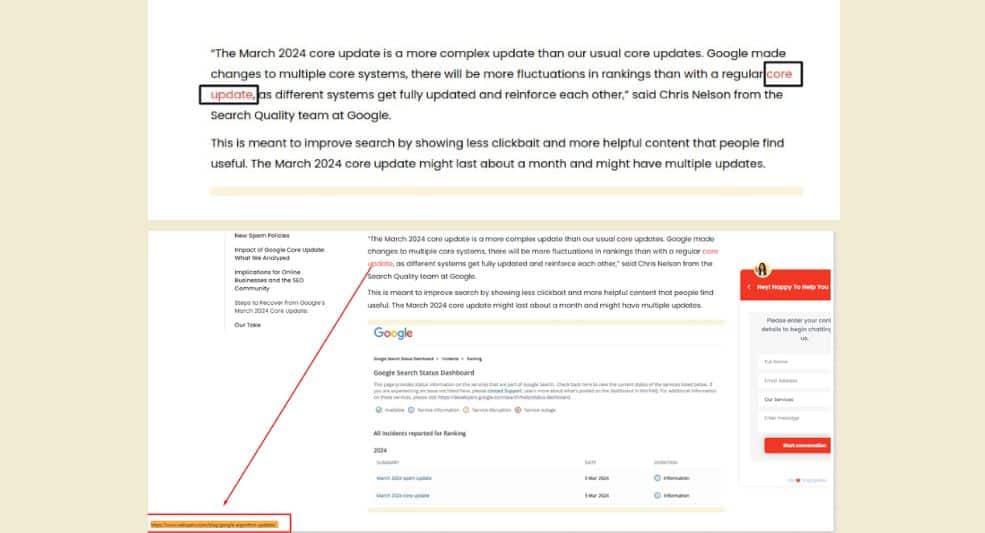
Generally, there are three types of links:
- Internal
- External
- Backlinks
Internal links take you to another page within the same website, while external ones lead to another resource.
Backlinks are links to your website/webpage on another page. They can be generated in 9 types of content:
- Editorial
- Business profiles
- Guest posts
- Webinars
- Tools
- Guest post bio
- Badge
- Comments
- Acknowledgment
Why Are Links Important?
They are incredibly important for a website’s SEO. The more hyperlinks to your website, the better it is for its health. However, it is also necessary to focus on quality links.
According to John Mueller, Google Search Advocate:
“My recommendation would be not to focus so much on the absolute count of links. There are many ways that search engines can discover websites, such as with sitemaps. There are more important things for websites nowadays, and over-focusing on links will often result in you wasting your time doing things that don’t make your website better overall.”
What Does Google API Content Warehouse Have On Links
The leaked document has 903 mentions of the word ‘link’, while ‘links’ have been mentioned 97 times. In addition, ‘anchor’ and ‘anchors’ have been used plenty of times. However, the majority of them aren’t associated with hyperlinks. We reviewed all of them and found some words and phrases that are very closely related to what we were looking for—links.
Let’s take a look at what we discovered so far:
1. Links – They Matter
What We Know So Far
In 2016, Google search quality strategist Andrey Lipattsev revealed the importance of links in Google Search ranking and called them one of the top three factors. However, Google’s Gary Illyes stated last year that ‘Links’ are no longer among the top factors.
What Does the Leak Say
Links matter.
PageRank, an algorithm developed by Larry Page and Sergey Brin, measures the importance of a webpage based on the quantity and quality of links pointing to it. It works on the principle that a page is more important if linked to other important pages.
PageRank is a complex algorithm that calculates a numerical value for each webpage, indicating its relative importance in the web graph. The leaked docs have ‘PageRank’ many times.
Our Verdict
The Google Search API Documents have mentioned ‘PageRank’ in multiple attributes of different types. This is strange because it was believed that Google had stopped using PageRank.
According to an ex-Googler:
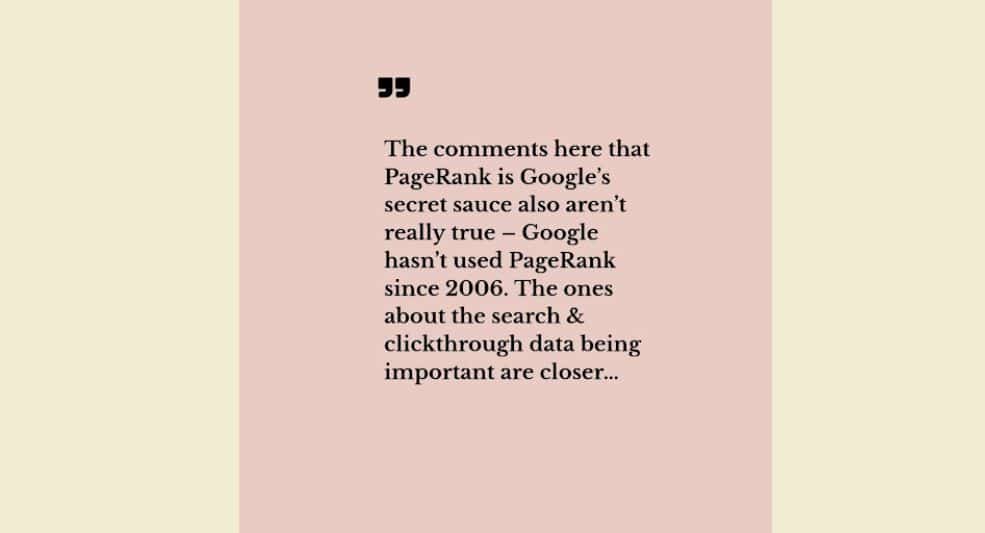
PageRank was very popular in the 90s. It was removed by Google as PankRank bar in 2006.
It’s evident that the search engine giant replaced it with a new PankRank: ‘PagerankNs’. It is because Google filed for a new patent in the same year.
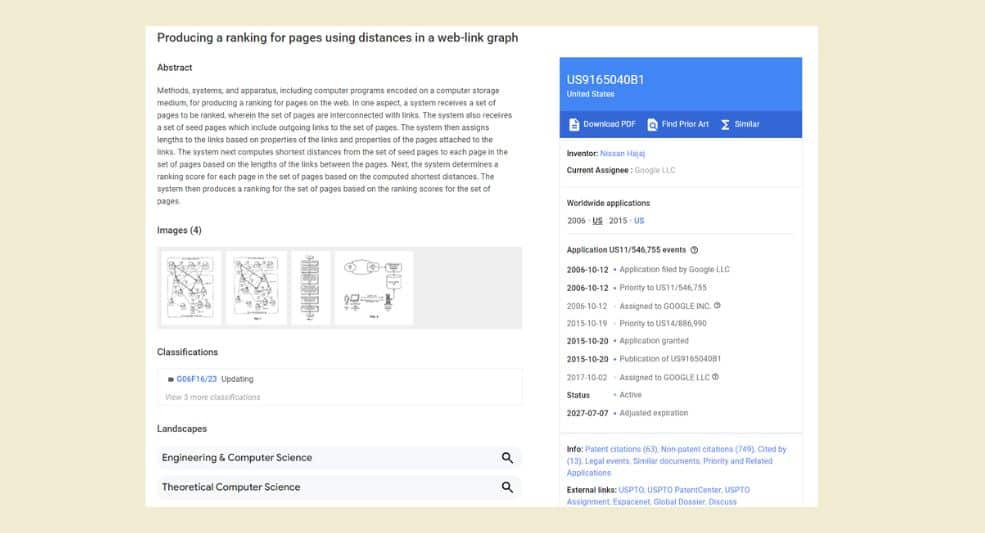
Find the patent here.
PageRank_NS is an enhanced Google algorithm designed to assess how relevant webpages are to search queries. The “NS” likely stands for Nearest Seeds, indicating an advanced algorithm that employs artificial intelligence to comprehend the context of webpages.

In the traditional PageRank method, the value of a webpage was determined solely by link analysis. However, PageRank_NS considers the quality and quantity of links and understands the semantics of web content.
PageRank_NS considers multiple factors to provide more relevant search results. These factors include the source’s credibility, the content’s freshness, user interactions, entity matching, and semantic analysis.
The traditional way of ranking a web page was a toolbar with values between 0 and 10. However, PageRank_NS uses unit 16 scale.
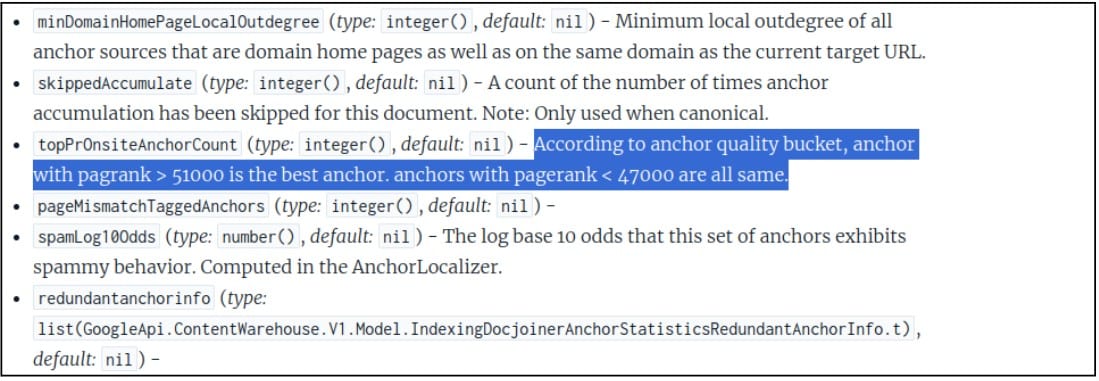
Also, considering the quality of an anchor, it decide the rankings. For example, an anchor with pagrank > 51000 is the best, while anchors with pagerank < 47000 are all the same.
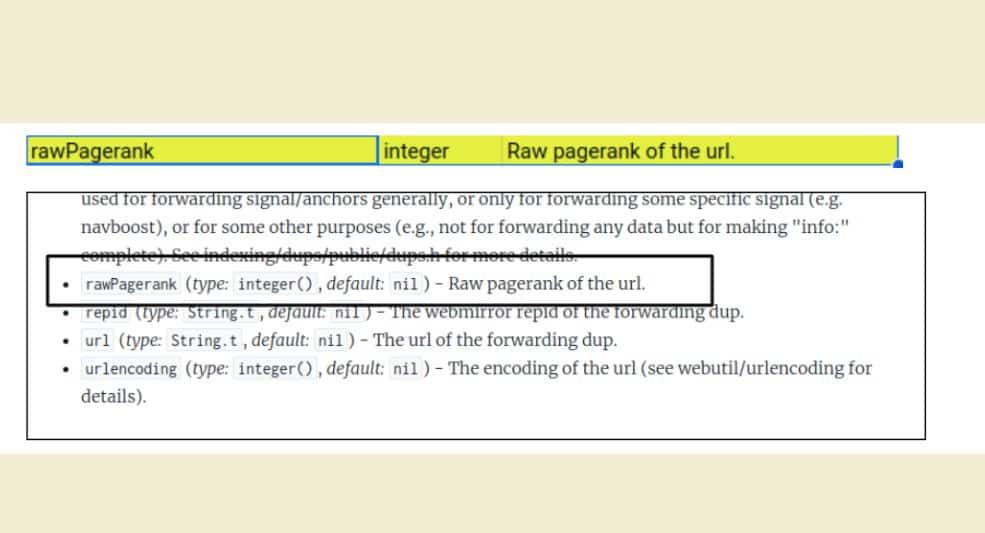
The leaked doc also contains RawPageRank – it refers to the unprocessed, unadjusted PageRank values assigned to webpages by Google’s algorithm. It’s essentially the pure, original PageRank score calculated for each page based solely on the web’s link structure.
2. Toxic backlinks – They’re Real
What We Know So Far
Toxic backlinks are generated when you use link-building bots, post unnatural links, and list your business on low-quality sites.
According to Google, there are algorithms that target unnatural links.
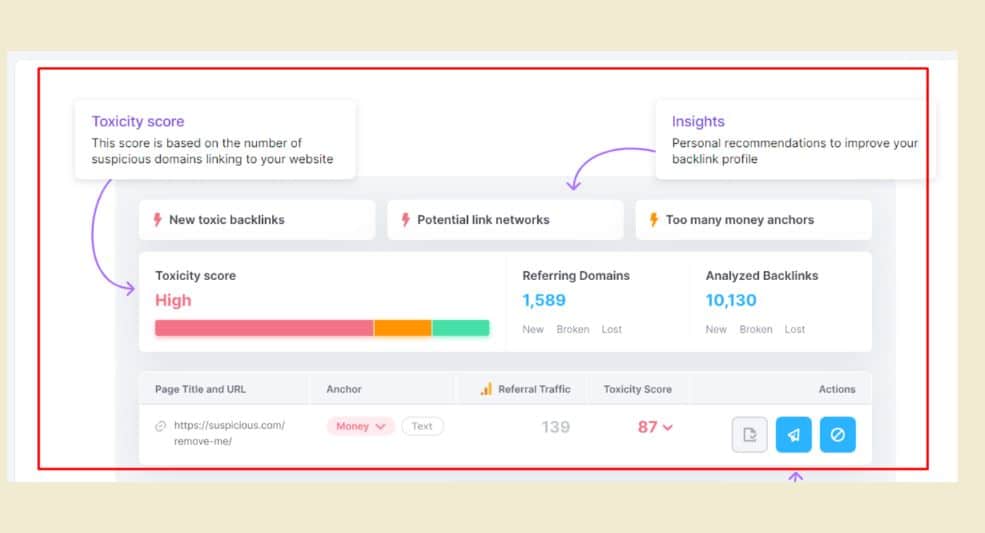
As you can see in the image above, the website is highly toxic.
What Does the Leak Say
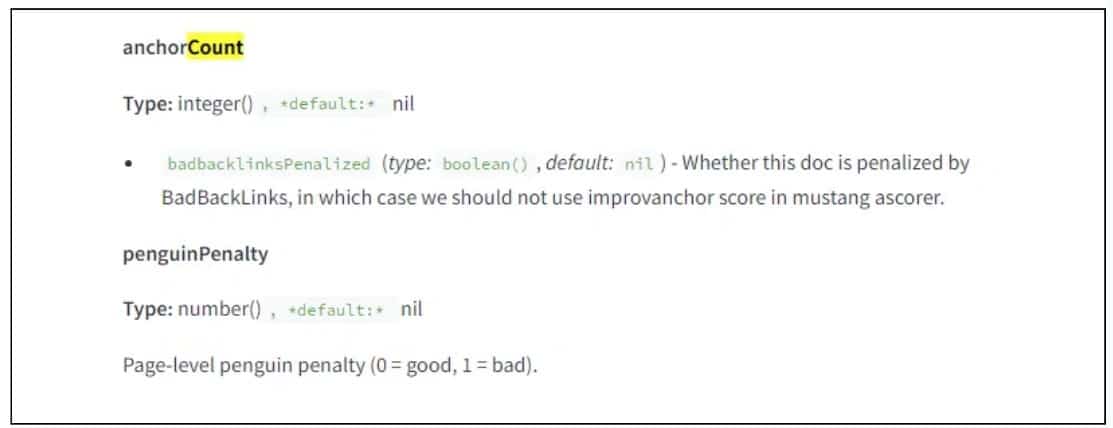
The Google API Content Warehouse has a ‘badbacklinksPenalized’ feature. It says, “If this doc is penalized by BadBackLinks, we should not use the improvanchor score in Mustang ascorer.”
Our Verdict
Toxic backlinks have always been a part of the SEO world. In the Google sheet, there’s mention of ‘The Penguin penalty’, which focuses on backlinks to identify poor-quality websites.
It is necessary to pay attention to toxic backlinks and get rid of them. With the help of tools like Semrush, they can be identified.
When it comes to removing them, you request Google to ignore specific backlinks to your site. Click here to learn more!
3. Anchor – Google Notes Context
What We Know So Far
In Google Search Central’s words, Anchor is text with a link that tells readers about another page your content is linked to.

Credit: Google Search Central
Anchors are very important. They provide context to search engines and readers. The link label tells what the reader will view on the linked page, while search engines use anchors to rank a webpage.
What Does the Leak Say
We know how to create an anchor. But until now, hardly anyone knew how Google analyzes it when considering the base page and source page for ranking purposes.
After decoding modules and attributes, we understand that Google notices Context, Context2, fullLeftContext, and fullRightContext for every anchor to identify its relevancy.
It means context is extremely important. Here, fullLeftContext and fullRightContext may mean that Google considers content on the left and right sides of the anchor, respectively.

Important: Please note that when we say ‘left and right sides of the anchor,’ it may refer to one sentence, paragraph, or the entire content.
Our Verdict
So, we can conclude that all the words or terms near an anchor play a key role in deciding its relevancy.
You can experiment to understand how it works.
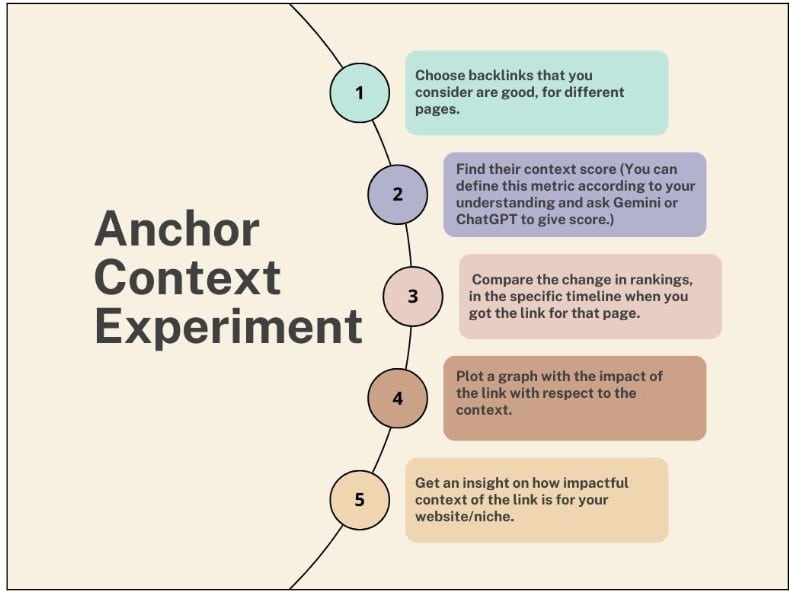
4. Anchor – Mismatch Leads to Demotion
What We Know So Far
Google uses anchor text to determine the relevance and context of another page linked to it. Mismatched anchors confuse readers and affect how search engines examine your anchor’s relevance to the target page.
Example of Good Anchor Link:
Anchor text: CopyLeaks Review
Target Link: https://www.webspero.com/blog/copyleaks-ai-content-detector-review-fact-or-fiction/
When readers see ‘CopyLeaks review’ in a blog, they will expect information about where the tool has been reviewed.
Example of Bad Anchor Link:Anchor text: CopyLeaks Review
Target Link: https://copyleaks.com/pricing
Readers expect a review here, but the target link takes them to the pricing page. This is an example of a bad anchor.
What Does the Leak Say

The ‘AnchorMismatchDemotion’ attribute in the leaked sheet hints at link demotion.
Our Verdict
If the target link doesn’t match the anchor text, it can create a frustrating reading experience. The mismatch can also lead to a poor page experience and a drop in rankings.
Google has always emphasized the importance of relevance on both sides of a link.
5. Anchor – Anchor Text Spamming is ‘Serious’
Anchor text spamming is obtaining links that all use the exact specific words. It’s as if every link to your site features identical anchor text. For example, if you have 1000 links pointing to your site and more than 900 of them have the same anchor text, Google will think this anchor text is spammy.
What Does the Leak Say
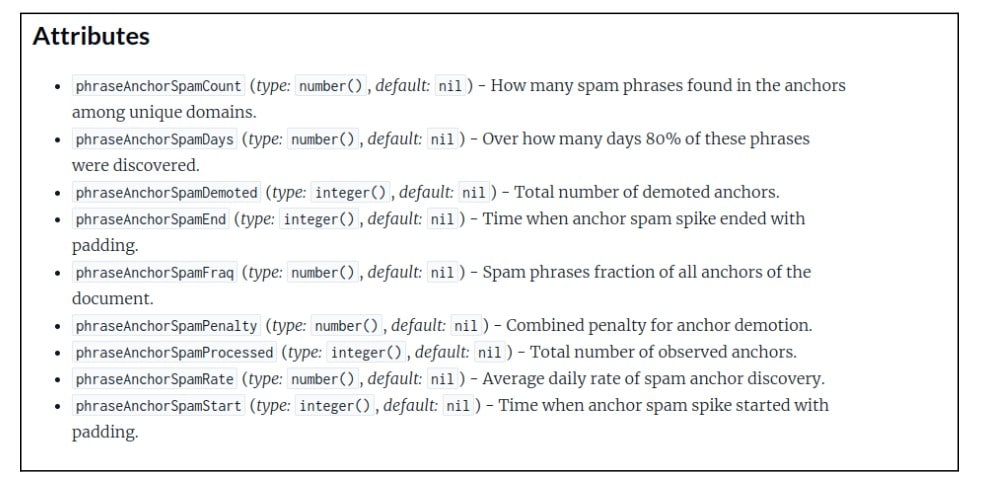
Various metrics are used to identify spikes in spam anchor text. One notable feature is the phrase ‘AnchorSpamDays’, which enables Google to measure the rate at which spam links are created.
The ‘AnchorSpamCount’ phrase counts the number of spam phrases in anchors, while ‘AnchorSpamDemoted’ focuses on total demoted anchors.
Similarly, phrases in the leaked docs consider the number of days of discovered spam phrases, combined penalty, the time when the anchor spam spike ended, and spam phrases fraction.
Our Verdict
Based on the leak’s information, Google has specific measures in place to combat anchor text spamming, including penalties for sites engaging in this practice. Therefore, it’s clear that Google considers anchor text spamming a significant violation of its guidelines, with potential consequences for offending websites.
6. Anchor – Link Source Quality Matters
In 2011, following the launch of the Panda update, Google announced that having low-quality content on any part of a website could negatively affect the site’s overall ranking.
Apart from website content, Google also evaluates the relevance and authority of the linking webpage.
What Does the Leak Say
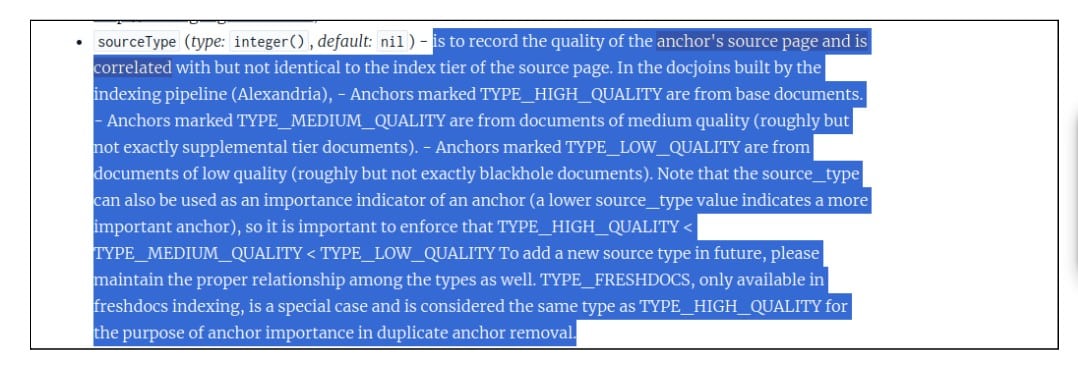
Google ranks the quality of link sources and categorizes them into three categories:
- Low
- Medium
- High
Links are marked as low, medium, or high, depending on the base documents. For example, a low-quality link is probably from a document with low-quality sources, while a high-quality link belongs to a high-quality source.
Our Verdict
Concentrate on acquiring high-quality, contextually relevant links from trusted and regularly updated pages. These links improve your site’s credibility and improve search engine rankings.
Review and update your content regularly by refreshing, refining, or removing low-quality or irrelevant pages. Redirect these outdated pages to stronger, more valuable sources to maintain your site’s integrity and relevance.
Ensure that every piece of content you produce accurately reflects your brand’s values and messaging. Keep your users engaged with well-crafted, informative, and appealing content that meets their needs and interests.
7. Homepage Links Have More Value
We know backlinks are good for a website’s SEO, referral traffic, and getting an edge over competitors. And, we also know that different website pages have different score when it comes to backlinking.
For example, Google assesses the authority of individual pages, not just the overall site. Also, pages with backlinks from high-authority sites will score better than those with fewer or lower-quality backlinks.
What Does the Leak Say

In the leaked documentation (within the AnchorsAnchorSource module), an attribute named homePageInfo is mentioned. This hints that Google categorizes link sources as untrusted, partially trusted, or fully trusted.
This may also mean that this attribute indicates when the source page is a website’s homepage, while a different value is assigned to other pages.
Our Verdict
It is possible that Google emphasizes a website’s homepage and puts more “trust” on it than other pages. How they do this is not known. We don’t know how Google determines whether a page is fully trusted, partially trusted, or not trusted.
However, internal pages may inherit the trustworthiness of the homepage. This could affect how links are weighted, with links from fully trusted sites being more valuable than those from less trusted ones.
8.Old Backlinks Help in Bad Times
Domain age, the number of referring domains, and the total number of linking pages are some well-known backlinking factors.
We also know that the Penguin update targets websites with many low-quality or irrelevant links pointing to them. However, the new Google Docs have more to offer. According to the leak, Google considers old backlines to rate a website.
What Does the Leak Say
There’s an attribute that hints at Google considering a website’s old backlinks when rating it. This may mean that even if your website has low-quality links pointing towards it, Google may consider old, high-quality backlinks before penalizing it.
Our Verdict
Old, high-quality backlinks are crucial. They can help maintain your site’s reputation and ranking when newer, lower-quality links might otherwise harm your SEO. Prioritize building and maintaining high-quality backlinks over time to ensure long-term stability and resilience in your search rankings.
As an SEO/Marketer, What Should Be Your Strategy
Don’t Obsess About the Number of Links
- Focus on Quality Over Quantity: Instead of getting as many backlinks as possible, focus on acquiring high-quality backlinks. A few links from reputable and authoritative websites can greatly impact your SEO than numerous links from low-quality sites.
- Avoid Link Farms and Spammy Links: Remember, backlinks from spammy sites can harm your website’s reputation and lead to penalties from search engines.
Context is Very Important
- Beyond Anchor Text: Although relevant anchor text is essential, the overall context of the linking page is equally important. Ensure the content surrounding the backlink is relevant and adds value to the reader.
- Relevance of Linking Page: The content of the page providing the backlink should be closely related to the topic of your linked page. Google evaluates the relevance of the linking page to determine the value of the backlink.
- Full Context Analysis: Google considers the full context around the anchor text, including the sentences and paragraphs that precede and follow it. This helps search engines understand the relevance and intent of the link.
Links are Important, Especially from Highly Trusted Sources
- Authority Matters: Backlinks from highly trusted and authoritative websites are extremely valuable. These links signal to search engines that your content is credible and worth ranking higher.
- Impact on Rankings: Links from highly trusted sources can significantly boost your search engine rankings, helping you outrank competitors and attract more organic traffic.
Experiment on Your Site’s Unique Data
- Data-Driven Approach: Regularly analyze your website’s unique data to understand the impact of your backlink strategy. Use analytics tools to monitor changes in traffic, rankings, and user behavior.
- A/B Testing: Conduct A/B tests to determine which backlinks and link-building strategies yield the best results for your site. Experiment with different anchor texts, linking contexts, and sources.
Wrap Up
Are links still relevant? Absolutely. When we look at the sheet, evidence strongly suggests that links remain crucial ranking signals. However, it’s not just about any links; Google values and rewards relevant ones.
The key point is relevance. Google likely ignores links from irrelevant sources, emphasizing the importance of relevance in link-building and digital PR efforts.
Should you change your approach to link building?
It depends. Outdated tactics may need revision, but earning links from reputable publications remains effective. Focus on pitching relevant stories rather than assuming all high-authority links will benefit.
